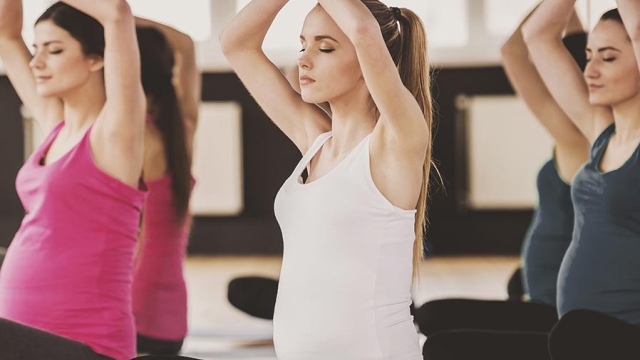Being pregnant is a beautiful and transformative experience that brings immense joy, but it can also come with its fair share of physical and emotional challenges. This is where prenatal yoga comes in, offering a gentle and nurturing way to stay active and connected to your growing baby while promoting overall well-being. Whether you’re new to yoga or a seasoned practitioner, prenatal yoga provides a safe and supportive environment to navigate the changes that come with pregnancy. In this article, we will explore the numerous benefits of prenatal yoga, from relieving pregnancy-related discomfort to enhancing mental and emotional balance. So, grab your mat and let’s dive into the world of prenatal yoga for beginners, discovering the best poses and practices that will help you find balance during this incredible journey.
Pure Silk Bonnet
Benefits of Prenatal Yoga
Firstly, prenatal yoga provides numerous physical benefits for expectant mothers. It helps improve flexibility and strength, which are crucial during pregnancy and childbirth. The gentle stretches and poses alleviate muscle tension and promote better posture. Additionally, practicing prenatal yoga can help relieve common discomforts such as back pain, swollen ankles, and fatigue.
Secondly, prenatal yoga offers a host of mental and emotional benefits. The focused breathing exercises and mindfulness techniques taught in prenatal yoga classes help pregnant women relax and reduce stress. This can be particularly beneficial as pregnancy often brings about a whirlwind of emotions. By practicing yoga, expectant mothers can find inner calmness and develop a positive mindset, enhancing their overall well-being.
Lastly, prenatal yoga fosters a sense of community and support among pregnant women. Group classes create a supportive environment where mothers-to-be can bond, share experiences, and build friendships. This social aspect provides emotional support and reassurance during a time of significant change and transition. Feeling connected to others who are going through a similar journey can be empowering and enhance the overall pregnancy experience.
In conclusion, the benefits of prenatal yoga extend beyond the physical aspect. It not only helps maintain a healthy body during pregnancy but also nurtures a peaceful mind and a sense of belonging. Incorporating prenatal yoga into one’s routine can contribute to a more enjoyable and fulfilling pregnancy journey.
Getting Started: Prenatal Yoga for Beginners
When embarking on your prenatal yoga journey, it’s essential to start with the right mindset and approach. Prenatal yoga offers numerous benefits for both the body and mind during pregnancy. Whether you’re new to yoga or have previous experience, here are some tips to get you started on your prenatal yoga practice.
Find a qualified instructor:
To ensure a safe and effective practice, it’s crucial to seek guidance from a certified prenatal yoga instructor. These professionals are trained to adapt poses and sequences specifically for pregnant women, taking into consideration the physical changes and limitations that come with pregnancy. A qualified instructor will provide you with the necessary modifications and support, making your practice enjoyable and beneficial.Listen to your body:

During pregnancy, your body goes through significant changes, and it’s essential to tune in and listen to what it needs. Prenatal yoga allows you to develop a deeper connection with your body, promoting relaxation and mindfulness. Be attentive to any discomfort or pain, and don’t hesitate to modify or skip poses that don’t feel right for you. Remember, every pregnancy is unique, and what works for one person may not work for another.Start with gentle and beginner-friendly poses:
If you’re new to yoga, it’s best to start with gentle poses that are safe for pregnant women. Modified versions of traditional yoga poses, such as gentle twists, standing poses, and seated stretches, are ideal for beginners. These poses help improve flexibility, strength, and balance while avoiding unnecessary strain on your body. As you become more comfortable and confident, you can gradually explore more advanced prenatal yoga sequences.
By following these tips, you’ll be on your way to a safe and rewarding prenatal yoga journey. Remember to always consult with your healthcare provider before starting any exercise program during pregnancy, and enjoy the many benefits that prenatal yoga has to offer.
Choosing the Best Prenatal Yoga Practice
When it comes to choosing the best prenatal yoga practice, there are a few factors to consider that can make a significant difference in your journey towards a healthy pregnancy. First and foremost, it is crucial to find a practice that is specifically designed for expectant mothers. Prenatal yoga classes are tailored to accommodate the unique needs and changes that occur in a woman’s body during pregnancy.
One important aspect to look for in a prenatal yoga class is the expertise of the instructor. A qualified instructor who has specialized knowledge in prenatal yoga can guide you safely through the poses, ensuring you are practicing in a way that supports both you and your baby. They can also provide modifications for different stages of pregnancy, helping you adapt the practice as your body continues to change.
Another consideration is the level of experience required for the class. If you are new to yoga or have limited experience, it is advisable to start with a prenatal yoga class for beginners. These classes are designed to introduce you to the foundations of prenatal yoga, gradually building strength, flexibility, and relaxation techniques specifically tailored for pregnancy. Starting with a beginner-friendly class can help you establish a solid foundation and gradually progress in your practice.
Lastly, it can be beneficial to explore different styles of prenatal yoga and find one that resonates with you. Some practices may focus more on gentle stretching and relaxation, while others may incorporate more dynamic movements and poses. Choosing a style that aligns with your preferences and goals can enhance your overall experience and ensure you enjoy the practice.
In conclusion, when choosing the best prenatal yoga practice, it is important to consider factors such as the expertise of the instructor, the level of experience required, and the style of yoga being taught. By finding a practice that meets your specific needs and preferences, you can fully reap the benefits of prenatal yoga and enjoy a healthier and more balanced pregnancy.







Recent Comments